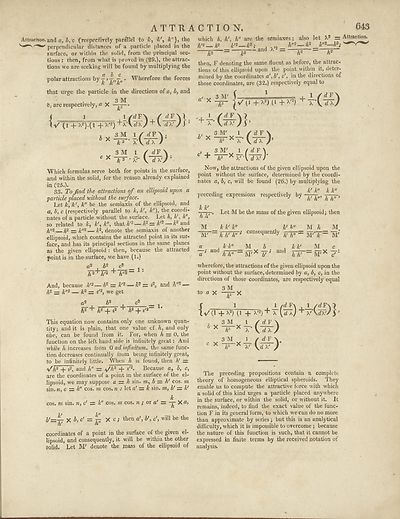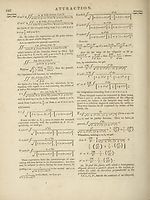Supplement to the fourth, fifth and sixth editions of the Encyclopaedia Britannica > Volume 1
(931) Page 643
Download files
Complete book:
Individual page:
Thumbnail gallery: Grid view | List view

ATTRACTION.
Attraction.and a, 5, c (respectively parallel to £, A:"), the
v perjK'ndicular distances of a particle placed in the
surface, or within the solid, from the principal sec¬
tions : then, from what is proved in (29.), the attrac¬
tions we are seeking will be found by multiplying the
polar attractions by j . Wherefore the forces
that urge the particle in the directions of a, b, and
3 M
fc, are respectively, o X
kz
which A, h\ h" are the semiaxes;
A'2 — A2 k'2 — F; , ,/2
p = p and "• =
then, F denoting the same fluent as before, the attrac¬
tions of this ellipsoid upon the point within it, deter¬
mined by the coordinates a', 6', c', in the directions of
those coordinates, are (32.) respectively equal to
3 M' ( 1 , 1 /■ F
-JT }•/(* + x'> T'V.T>:
643
7? rr Attraction.
a' X
)
V (i + A2).(1 + V2)
b X
c X
+
3 M
k 3
3 M
k 3
KS)+(5)}‘
•?(#)'
H-S)'
Which formulas serve both for points in the surface,
and within the solid, for the reason already explained
in (25.).
33. To find the attractions of an ellipsoid upon a
particle placed without the surface.
Let k, kr, k" be the semiaxis of the ellipsoid, and
a, b, c (respectively parallel to k, k', k"), the coordi¬
nates of a particle without the surface. Let h, h\ h",
so related to A, A', A", that h'- — h2 = k'- — A2 and
h"2 h2zzk"2—A2, denote the semiaxis of another
ellipsoid, which contains the attracted point in its sur¬
face, and has its principal sections in the same planes
as the given ellipsoid : then, because the attracted
point is in the surface, we have (1.)
02 A2 c2 _ _
+ A"2 ~ :
And, because A'2—h2 — A'2—-A2= s2, and A''- —
h2 — A"2 — A2 = s'2, we get
a2 62 . c2 ,
A2 + A2 + s2 + A2 -f s'2
This equation now contains only one unknown quan¬
tity; audit is plain, that one value of A, and only
one, can be found from it. For, when A = 0, the
function on the left hand side is infinitely great: And
while A increases from 0 ad infinitum, the same func¬
tion decreases continually from being infinitely great,
to be infinitely little. When A is found, then h' =
■\/A2 + s2, and A" = t/h? + s'2. Because c, b, c,
are the coordinates of a point in the surface of the el¬
lipsoid, we may suppose a — h sin. m^b •=. h’ cos. m
sin. n,c zz h" cos. m cos. n : let a' k sin. m, b' = h’
, *
cos. m sin. «, c' = A" cos. m cos. n ; or a' X
b'z~ X b,c' = ^ X cj then a', b’, c\ will be the
A u
coordinates of a point in the surface of the given el¬
lipsoid, and consequently, it will be within the other
solid. Let M' denote the mass of the ellipsoid of
Now, the attractions of the given ellipsoid upon the
point without the surface, determined by the coordi¬
nates a, A, c, will be found (2b.) by multiplying the
A' A" A A"
preceding expressions respectively by
A A'
A A' ‘
Let M be the mass of the given ellipsoid; then
M A A' A" , A' ft" M A M
M' ” A A' A" '* consecluently /7^T= M'* A “ M'
and
A A"
/TF”
M _A
M'X b'
and
A A'
A A'
M c_
M'X c'
wherefore, the attractions of the given ellipsoid upon the
point without the surface, determined by ct, A, c, in the
directions of those coordinates, are respectively equal
to a X
3 M
A3
X
{
^(1 + X2) (1 + X'2)+ X
3 M 1 / d F
■h'Kd-k'/ y
b X
c X
A3
3 M
A3
1 / \
x T ylfk )
x± /ALV
^ X' \dx' )
Tlie preceding propositions contain a complete
theory of homogeneous elliptical spheroids. They
enable us to compute the attractive force with which
a solid of this kind urges a particle placed anywhere
in the surface, or within the solid, or without it. It
remains, indeed, to find the exact value of the func¬
tion F in its general form, to which we can do no more
than approximate by series ; but this is an analytical
difficulty, which it is impossible to overcome ; because
the nature of this function is such, that it cannot be
expressed in finite terms by the received notation of
analysis.
Attraction.and a, 5, c (respectively parallel to £, A:"), the
v perjK'ndicular distances of a particle placed in the
surface, or within the solid, from the principal sec¬
tions : then, from what is proved in (29.), the attrac¬
tions we are seeking will be found by multiplying the
polar attractions by j . Wherefore the forces
that urge the particle in the directions of a, b, and
3 M
fc, are respectively, o X
kz
which A, h\ h" are the semiaxes;
A'2 — A2 k'2 — F; , ,/2
p = p and "• =
then, F denoting the same fluent as before, the attrac¬
tions of this ellipsoid upon the point within it, deter¬
mined by the coordinates a', 6', c', in the directions of
those coordinates, are (32.) respectively equal to
3 M' ( 1 , 1 /■ F
-JT }•/(* + x'> T'V.T>:
643
7? rr Attraction.
a' X
)
V (i + A2).(1 + V2)
b X
c X
+
3 M
k 3
3 M
k 3
KS)+(5)}‘
•?(#)'
H-S)'
Which formulas serve both for points in the surface,
and within the solid, for the reason already explained
in (25.).
33. To find the attractions of an ellipsoid upon a
particle placed without the surface.
Let k, kr, k" be the semiaxis of the ellipsoid, and
a, b, c (respectively parallel to k, k', k"), the coordi¬
nates of a particle without the surface. Let h, h\ h",
so related to A, A', A", that h'- — h2 = k'- — A2 and
h"2 h2zzk"2—A2, denote the semiaxis of another
ellipsoid, which contains the attracted point in its sur¬
face, and has its principal sections in the same planes
as the given ellipsoid : then, because the attracted
point is in the surface, we have (1.)
02 A2 c2 _ _
+ A"2 ~ :
And, because A'2—h2 — A'2—-A2= s2, and A''- —
h2 — A"2 — A2 = s'2, we get
a2 62 . c2 ,
A2 + A2 + s2 + A2 -f s'2
This equation now contains only one unknown quan¬
tity; audit is plain, that one value of A, and only
one, can be found from it. For, when A = 0, the
function on the left hand side is infinitely great: And
while A increases from 0 ad infinitum, the same func¬
tion decreases continually from being infinitely great,
to be infinitely little. When A is found, then h' =
■\/A2 + s2, and A" = t/h? + s'2. Because c, b, c,
are the coordinates of a point in the surface of the el¬
lipsoid, we may suppose a — h sin. m^b •=. h’ cos. m
sin. n,c zz h" cos. m cos. n : let a' k sin. m, b' = h’
, *
cos. m sin. «, c' = A" cos. m cos. n ; or a' X
b'z~ X b,c' = ^ X cj then a', b’, c\ will be the
A u
coordinates of a point in the surface of the given el¬
lipsoid, and consequently, it will be within the other
solid. Let M' denote the mass of the ellipsoid of
Now, the attractions of the given ellipsoid upon the
point without the surface, determined by the coordi¬
nates a, A, c, will be found (2b.) by multiplying the
A' A" A A"
preceding expressions respectively by
A A'
A A' ‘
Let M be the mass of the given ellipsoid; then
M A A' A" , A' ft" M A M
M' ” A A' A" '* consecluently /7^T= M'* A “ M'
and
A A"
/TF”
M _A
M'X b'
and
A A'
A A'
M c_
M'X c'
wherefore, the attractions of the given ellipsoid upon the
point without the surface, determined by ct, A, c, in the
directions of those coordinates, are respectively equal
to a X
3 M
A3
X
{
^(1 + X2) (1 + X'2)+ X
3 M 1 / d F
■h'Kd-k'/ y
b X
c X
A3
3 M
A3
1 / \
x T ylfk )
x± /ALV
^ X' \dx' )
Tlie preceding propositions contain a complete
theory of homogeneous elliptical spheroids. They
enable us to compute the attractive force with which
a solid of this kind urges a particle placed anywhere
in the surface, or within the solid, or without it. It
remains, indeed, to find the exact value of the func¬
tion F in its general form, to which we can do no more
than approximate by series ; but this is an analytical
difficulty, which it is impossible to overcome ; because
the nature of this function is such, that it cannot be
expressed in finite terms by the received notation of
analysis.
Set display mode to:
![]() Universal Viewer |
Universal Viewer | ![]() Mirador |
Large image | Transcription
Mirador |
Large image | Transcription
Images and transcriptions on this page, including medium image downloads, may be used under the Creative Commons Attribution 4.0 International Licence unless otherwise stated. ![]()
| Encyclopaedia Britannica > Supplement to the fourth, fifth and sixth editions of the Encyclopaedia Britannica > Volume 1 > (931) Page 643 |
|---|
| Permanent URL | https://digital.nls.uk/193166240 |
|---|
| Attribution and copyright: |
|
|---|
| Description | Ten editions of 'Encyclopaedia Britannica', issued from 1768-1903, in 231 volumes. Originally issued in 100 weekly parts (3 volumes) between 1768 and 1771 by publishers: Colin Macfarquhar and Andrew Bell (Edinburgh); editor: William Smellie: engraver: Andrew Bell. Expanded editions in the 19th century featured more volumes and contributions from leading experts in their fields. Managed and published in Edinburgh up to the 9th edition (25 volumes, from 1875-1889); the 10th edition (1902-1903) re-issued the 9th edition, with 11 supplementary volumes. |
|---|---|
| Additional NLS resources: |
|

